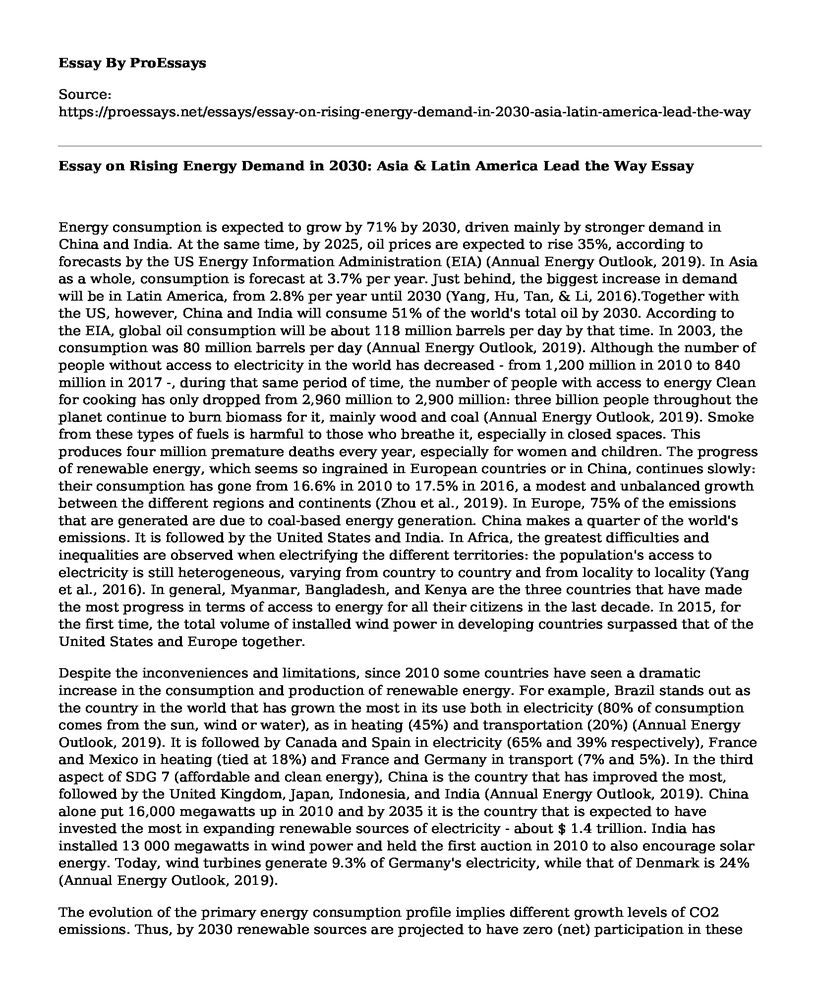Energy consumption is expected to grow by 71% by 2030, driven mainly by stronger demand in China and India. At the same time, by 2025, oil prices are expected to rise 35%, according to forecasts by the US Energy Information Administration (EIA) (Annual Energy Outlook, 2019). In Asia as a whole, consumption is forecast at 3.7% per year. Just behind, the biggest increase in demand will be in Latin America, from 2.8% per year until 2030 (Yang, Hu, Tan, & Li, 2016).Together with the US, however, China and India will consume 51% of the world's total oil by 2030. According to the EIA, global oil consumption will be about 118 million barrels per day by that time. In 2003, the consumption was 80 million barrels per day (Annual Energy Outlook, 2019). Although the number of people without access to electricity in the world has decreased - from 1,200 million in 2010 to 840 million in 2017 -, during that same period of time, the number of people with access to energy Clean for cooking has only dropped from 2,960 million to 2,900 million: three billion people throughout the planet continue to burn biomass for it, mainly wood and coal (Annual Energy Outlook, 2019). Smoke from these types of fuels is harmful to those who breathe it, especially in closed spaces. This produces four million premature deaths every year, especially for women and children. The progress of renewable energy, which seems so ingrained in European countries or in China, continues slowly: their consumption has gone from 16.6% in 2010 to 17.5% in 2016, a modest and unbalanced growth between the different regions and continents (Zhou et al., 2019). In Europe, 75% of the emissions that are generated are due to coal-based energy generation. China makes a quarter of the world's emissions. It is followed by the United States and India. In Africa, the greatest difficulties and inequalities are observed when electrifying the different territories: the population's access to electricity is still heterogeneous, varying from country to country and from locality to locality (Yang et al., 2016). In general, Myanmar, Bangladesh, and Kenya are the three countries that have made the most progress in terms of access to energy for all their citizens in the last decade. In 2015, for the first time, the total volume of installed wind power in developing countries surpassed that of the United States and Europe together.
Despite the inconveniences and limitations, since 2010 some countries have seen a dramatic increase in the consumption and production of renewable energy. For example, Brazil stands out as the country in the world that has grown the most in its use both in electricity (80% of consumption comes from the sun, wind or water), as in heating (45%) and transportation (20%) (Annual Energy Outlook, 2019). It is followed by Canada and Spain in electricity (65% and 39% respectively), France and Mexico in heating (tied at 18%) and France and Germany in transport (7% and 5%). In the third aspect of SDG 7 (affordable and clean energy), China is the country that has improved the most, followed by the United Kingdom, Japan, Indonesia, and India (Annual Energy Outlook, 2019). China alone put 16,000 megawatts up in 2010 and by 2035 it is the country that is expected to have invested the most in expanding renewable sources of electricity - about $ 1.4 trillion. India has installed 13 000 megawatts in wind power and held the first auction in 2010 to also encourage solar energy. Today, wind turbines generate 9.3% of Germany's electricity, while that of Denmark is 24% (Annual Energy Outlook, 2019).
The evolution of the primary energy consumption profile implies different growth levels of CO2 emissions. Thus, by 2030 renewable sources are projected to have zero (net) participation in these emissions, while petroleum derivatives (diesel oil, gasoline, LPG [liquefied petroleum gas] and kerosene) will account for most of the emissions, with a share of about 50% (Annual Energy Outlook, 2019). Natural gas, although having lower emission factors than other fossil fuels, would increase its share to approximately 17%, as a result of the higher employment in industry and electricity generation (Annual Energy Outlook, 2019). With the expansion of the steel industry and the spread of coal-fired thermoelectric plants, which lead to an increase in the consumption of coal and derivatives, this energy source would account for about 16% of emissions. As for the specific emissions (per unit of energy consumed), it is assumed that they may grow in the short term. In the long run, however, after the effects of the initial conditions and the inertial factors that influence the behavior of the economy and the energy demand, these emissions would show a declining trend due to the increase in the share of renewable sources. Over the projected period, the specific carbon dioxide emissions index were 1.62t CO 2/ toe in 2005, peaking at 1.79 in...
Cite this page
Essay on Rising Energy Demand in 2030: Asia & Latin America Lead the Way. (2023, Feb 11). Retrieved from https://proessays.net/essays/essay-on-rising-energy-demand-in-2030-asia-latin-america-lead-the-way
If you are the original author of this essay and no longer wish to have it published on the ProEssays website, please click below to request its removal:
- Paper Example on Disruptive Innovation and Education
- Essay on Should Children Carry Cell Phones to School?
- Environmental Issues Essay Example
- Essay on Global and National Awareness on Global Warming
- Essay Sample on Data Revolution: Unlocking Business Insights with the Power of AI and IoT
- Essay Example on Green Theory: A Framework for International Cooperation on Environmental Issues
- Trader Joe: Delivering Innovation & Quality at a Reasonable Price - Essay Sample







